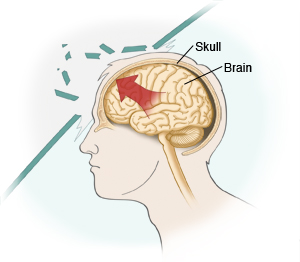You have been diagnosed with a head injury. Your condition seems stable at this time. But symptoms of a more serious problem, such as mild brain injury (concussion) or bruising or bleeding in the brain, may appear later. For this reason, you and someone caring for you will need to watch for any of the new or worse symptoms listed below. Once at home, also be sure to follow any other care instructions you’re given.
Home care
Symptoms to watch for
Someone must stay with you for the next 24 hours or longer, as directed. If you fall asleep, this person should wake you up every 2 hours or as directed to check your symptoms. This is called sleep monitoring. Symptoms to watch for include:
-
A headache that lasts or gets worse.
-
An upset stomach (nausea) or vomiting.
-
Dizziness.
-
Sensitivity to light or noise.
-
Abnormal sleepiness or grogginess.
-
Trouble falling asleep.
-
Personality changes.
-
Vision changes.
-
Memory loss.
-
Confusion.
-
Trouble walking or clumsiness.
-
Loss of consciousness, even for a short time.
-
Inability to be woken up.
-
A stiff neck.
-
Weakness or numbness in any part of the body.
-
Seizures.
-
Bruising behind the ears or around the eyes.
If you have any of these symptoms, get emergency medical care right away. If none of these symptoms are noted during the first 24 hours, keep watching for any symptoms for the next day or so. Ask your provider if someone should stay with you during this time.
General care
-
If you were prescribed medicines for pain, use them as directed. Don’t use other pain medicines without checking with your provider first.
-
To help reduce swelling and pain, apply a cold source to the injured area for up to 20 minutes at a time. Do this as often as directed. Use a cold pack or bag of ice wrapped in a thin towel. Never apply a cold source directly to the skin.
-
If you have cuts or scrapes as a result of your injury, care for them as directed.
-
For the next 24 hours (or longer, if instructed):
-
Don’t drink alcohol or use sedatives or other medicines that make you sleepy.
-
Don’t drive or operate machinery.
-
Don’t do anything strenuous, such as heavy lifting or straining.
-
Limit tasks that require concentration. This includes reading, using a smartphone or computer, watching TV, and playing video games.
-
Don’t return to sports or other activities that could result in another head injury.
-
Follow-up care
Follow up with your health care provider as directed. If imaging tests were done, they'll be reviewed by a provider. You'll be told the results and any new findings that may affect your care.
When to get medical advice
Contact your provider or seek medical care right away if you have:
-
Pain doesn’t get better or gets worse.
-
New or increased swelling or bruising.
-
A fever of 100.4°F (38°C) or higher or as advised by your provider.
-
Redness, warmth, bleeding, or drainage from the injured area.
-
Any depression or bony abnormality in the injured area.
-
Fluid drainage or bleeding from the nose or ears.
-
Bruising behind the ears or around the eyes.
-
Lethargy or excessive sleepiness.
-
Personality changes.


